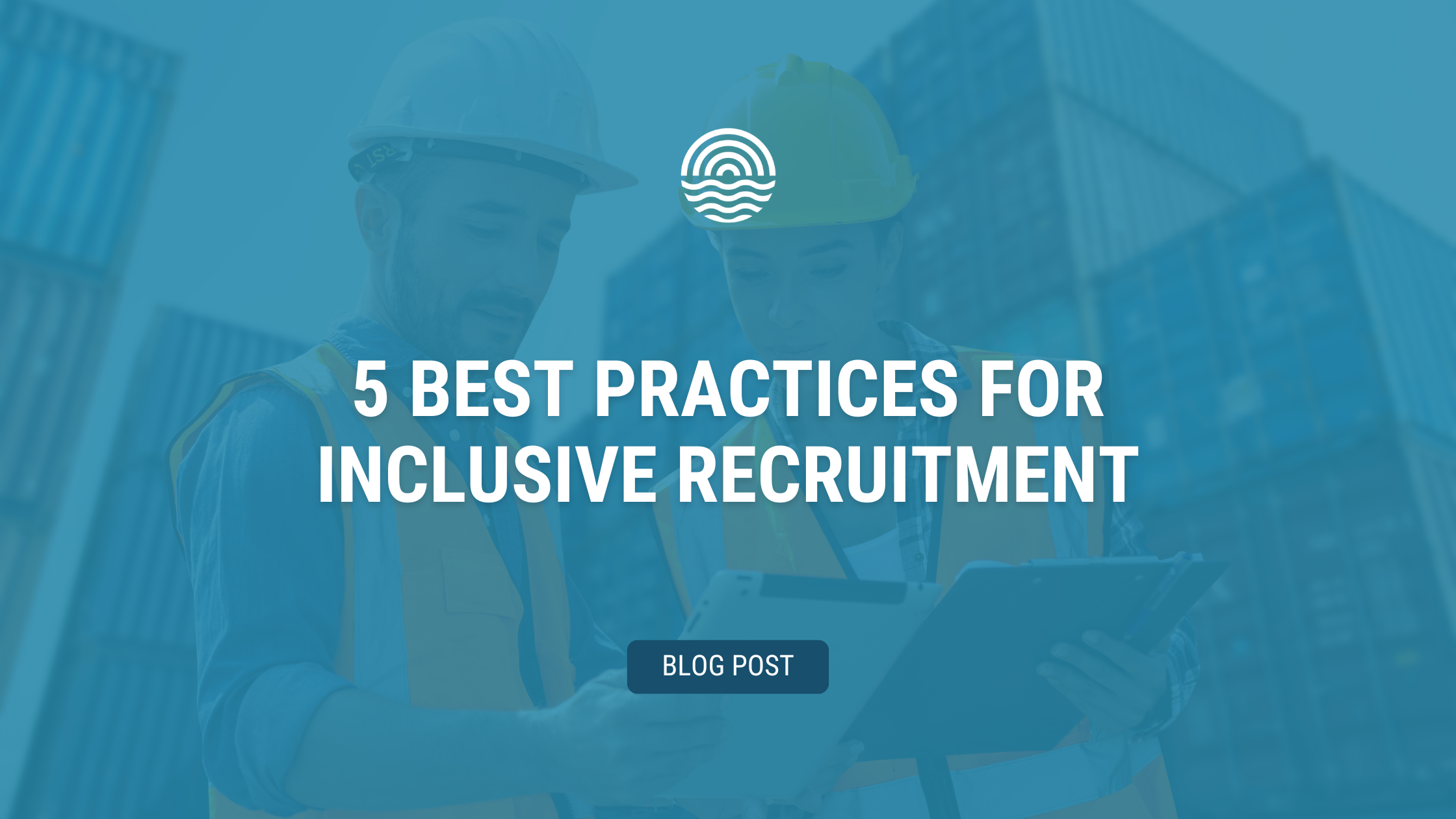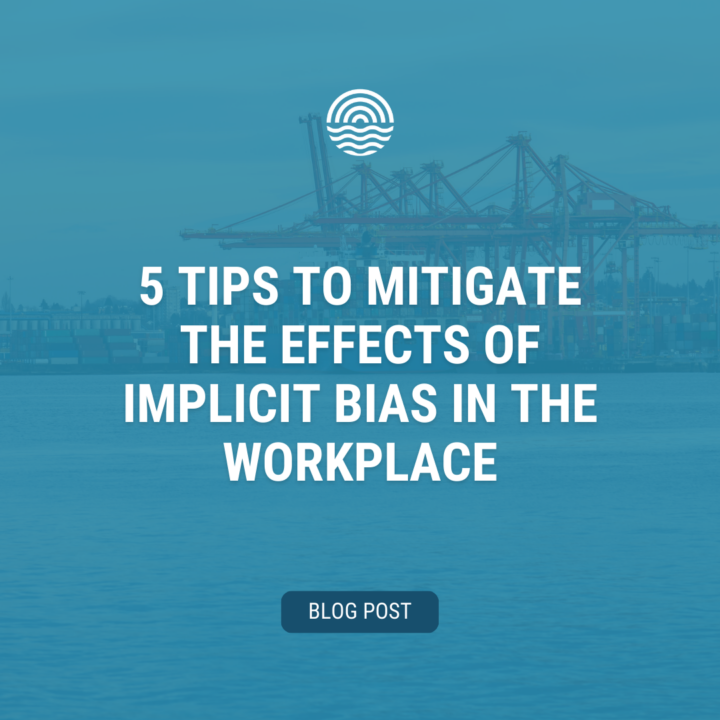
BLOG POST
5 Best Practices for Inclusive Recruitment in the Waterfront Industry
Is your recruitment process inclusive?
Ensuring an inclusive and equitable recruitment process is key to attracting and retaining top talent in the waterfront industry.
Embracing diversity not only strengthens your workforce but also fosters an environment where all team members feel valued, supported, and empowered. By championing inclusivity in your recruitment practices, you not only meet the demands of a changing industry but also pave the way for a more innovative, resilient, and harmonious workplace!
5 Best Practices for Inclusive Recruitment in the Waterfront Industry
Here are 5 best practices for creating an inclusive recruitment process in the waterfront industry:
1. Use Gender-Neutral Language
Language plays a pivotal role in attracting diverse candidates. Ensure your job postings use gender-inclusive language, avoiding gendered terms that might unintentionally discourage both women and individuals from underrepresented genders.
Instead, focus on emphasizing the qualifications and skills required for the position, creating an inclusive space that appeals to a broad spectrum of talents.
Example: Replace “Looking for a strong leader” with “Seeking an effective leader with strong leadership skills.”
Additionally, it’s also important to consider language when naming roles, especially on the waterfront. In the traditionally male-dominated waterfront industry, many role titles may have a gender-specific connotation. By opting for more gender-neutral titles, we can contribute to creating a more inclusive and welcoming environment for individuals of all gender identities.
Example:
| Traditional | Gender-Neutral |
|---|---|
| Longshoreman | Terminal Operator |
| Foreman | Foreperson |
2. Conduct Bias Training with Your Recruitment Team
Bias can often seep into the recruitment process unconsciously. Consider conducting bias training with your recruitment team.
Bias training equips your recruitment team with the knowledge and tools to recognize and address unconscious biases that may inadvertently influence decision-making during the hiring process. By fostering awareness of potential biases related to gender, race, age, or other factors, your team can actively work to eliminate these influences.
This allows recruiters to focus solely on skills, qualifications, and experience, ensuring a fair and unbiased evaluation of candidates.
3. Showcase Your Authentic Employer Brand, Employer Values, & Employee Success Stories
Authenticity is a powerful driver in attracting top talent to the waterfront industry.
Your organization’s employer brand should be transparent and genuine, effectively communicating its mission, vision, and values. By highlighting unique aspects of your workplace culture, such as inclusivity, equal opportunities, and a commitment to professional development, you foster trust and draw in candidates who resonate with your organizational ethos.
A crucial aspect of authenticity lies in showcasing core values that guide decision-making at every level of your organization. Whether it’s a dedication to safety, sustainability, or innovation, transparently communicating these values helps potential candidates align themselves with your workplace culture. This clarity allows individuals to determine if they share a common vision with your organization, contributing to a more meaningful connection between employees and your company.
To bring these values to life, leverage the power of employee success stories. Feature testimonials, case studies, or profiles that highlight the achievements and career progression of individuals within your diverse workforce. By sharing these narratives across various platforms, including your company website, social media, and industry publications, you not only communicate your authentic employer brand effectively but also reach potential candidates where they engage most. This strategy not only attracts talent aligned with your values and mission but also contributes to the creation of a diverse and inclusive waterfront workplace that fosters long-term success for both employees and your organization.
Ultimately, showcasing your company authentically shows potential candidates that they belong and can thrive in your workplace.
4. Use Standardized Interview Questions
During the interview process, it’s important to create an inclusive atmosphere by using standardized interview questions. Standardized interview questions are questions that focus on skills and experience rather than personal details.
This approach helps to ensure that each candidate is assessed on their merit, fostering a fair evaluation that reduces potential opportunities for bias. Standardized questions are great for establishing consistency across interviews and gauging how well candidates meet specific job requirements.
Additionally, consider incorporating scenario-based or situational questions that assess a candidate’s problem-solving skills, adaptability, and collaboration abilities. By emphasizing these competencies, you shift the focus away from subjective judgments and create a more objective evaluation process. This approach also provides candidates with an opportunity to authentically demonstrate their abilities and suitability for the role.
5. Use Inclusive Imagery on Your Website (+ Showcase Your Team!)
When a candidate is looking to apply for a job at your company, one of the first things they’ll do is visit your website. Candidates want to get a better idea of what you do and who you are.
A great first step to attracting diverse top talent and ensuring your recruitment process is inclusive to all genders is to ensure your website reflects your commitment to inclusivity. One way this can be done is by incorporating diverse and inclusive imagery that showcases the variety of individuals contributing to your workplace. This provides a visual representation of your inclusive culture and showcases what it’s like to work on your team.
Where possible, include photos of team members engaging in various activities, celebrating achievements, and participating in company events. This helps to authentically communicate what it’s like to work with your company through visuals. It also humanizes your employer brand and helps candidates envision themselves as part of a vibrant and inclusive professional community!
Final Thoughts
By implementing these best practices, you can create a culture that attracts, retains, and empowers talent from all backgrounds, contributing to a more resilient and diverse maritime workplace and industry as a whole!
Questions about making your hiring process more inclusive? We can help!


